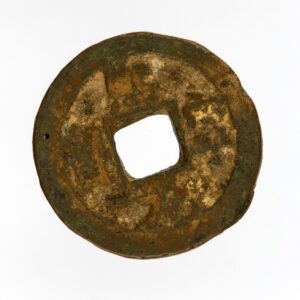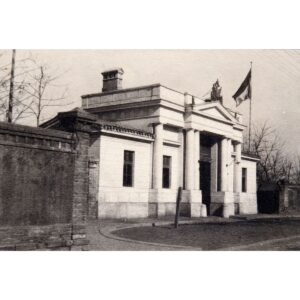Photography The Official Entrance to the French Legation
A black-and-white photograph showing the main entrance of the French embassy or legation in the diplomatic quarter in Beijing (Dongjiaominxiang 東交民巷). Between 1861 and 1959, the latter was established in the Inner City area (Neicheng 内城), east of present-day Tiananmen Square (Tiananmen Guangchang 天安門廣場), and south of the Forbidden City (Gugong 故宫 or Zijincheng 紫禁城). The areas of each legation were surrounded by a wall. In the legations, the foreign powers built various infrastructures – from churches, hospitals, barracks, post offices, and schools to banks and horse racing tracks. Access to the legation was possible at certain points through a designated portal and a guardhouse over which the national flag was hoisted.
In front of the entrance stands a pair of shishi 石獅 lion guards. Statues in the form of a mythological half-lion, half-dog are placed on one side of the entrance as guards of the legation. The motif of lion guardians is a popular ... more
A black-and-white photograph showing the main entrance of the French embassy or legation in the diplomatic quarter in Beijing (Dongjiaominxiang 東交民巷). Between 1861 and 1959, the latter was established in the Inner City area (Neicheng 内城), east of present-day Tiananmen Square (Tiananmen Guangchang 天安門廣場), and south of the Forbidden City (Gugong 故宫 or Zijincheng 紫禁城). The areas of each legation were surrounded by a wall. In the legations, the foreign powers built various infrastructures – from churches, hospitals, barracks, post offices, and schools to banks and horse racing tracks. Access to the legation was possible at certain points through a designated portal and a guardhouse over which the national flag was hoisted.
In front of the entrance stands a pair of shishi 石獅 lion guards. Statues in the form of a mythological half-lion, half-dog are placed on one side of the entrance as guards of the legation. The motif of lion guardians is a popular one in Chinese Buddhism. It probably evolved from the depiction of dogs as protectors of the Dharma in India. Stylised lions stood at the entrances of tombs, palaces and government buildings in China and other Buddhist sites in Asia. The oldest statues in China date back to the 3rd century B.C. They are said to protect against harmful spirits and human actions. The male often has a ball under his paw, the female a lion cub.
The photograph is the 51st of 449 photographs of Beijing and its surroundings in the album of Ivan Skušek Jr., purchased during his stay in Beijing (1914–1920). In the handwritten inventory of the album, the photograph is referred to as Tor der franz. Legation.





































Do you have a comment or additional information about the subject?